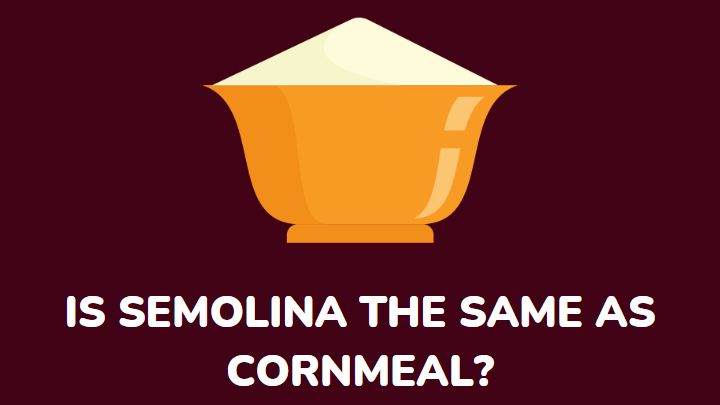People often ask if they can substitute semolina for cornmeal for dusting pizza peel. The answer is yes. Both can be used for dusting pans or surfaces.
But, they have a lot of differences which range from source to uses, taste, and nutrients. A major difference is that semolina is obtained from durum wheat while cornmeal is ground dried field corn which can be fine, medium, or coarse.
Moreover, semolina and cornmeal look so alike that it’s easy to mistake them for each other. This article points out the differences and similarities between semolina and cornmeal.
What is semolina?
Semolina is a coarse, pale-yellow flour obtained from a type of wheat called durum wheat. Durum wheat is the hardest species of wheat predominantly found in the middle east.
Milling these hard grains is a difficult and time-consuming process. The result of ground durum wheat is coarse sand-like semolina flour with a mild, earthy aroma.
Semolina makes a tough dough that holds up well in any shape. Its texture makes it suitable for making porridge, bread, and pasta especially.
Also, semolina is darker and is more golden than cornmeal or all-purpose flour. It contains high amounts of protein and gluten.
Uses of semolina
Semolina is used for:
- Making pasta or couscous
- Making solid swallow foods in Africa
- Making Khobz, a Moroccan oven-baked round flatbread
- Sweet pudding or porridge
- Cakes, bread, and pies
- Dusting pizza peels
What is cornmeal?
Cornmeal is ground-dried field corn that has a fine, medium, or coarse texture. The texture is dependent on the milling process that it undergoes.
In America, degermed yellow cornmeal is the most common variant found in stores. Degermed yellow cornmeal is rid of its germs and hulls and is ground into fine powder in steel rollers.
It loses a lot of nutrients during milling which can be added back after processing. The good thing about steel-ground yellow cornmeal is that it is free of gluten and has a shelf life of a year or more.
The total opposite of degermed yellow cornmeal is steel ground cornmeal. It’s ground on big stones and doesn’t have its hull and germs removed.
As a result, stone-ground cornmeal is coarse and retains most of its nutrients after processing. It also adds a more predominant corn flavor to food compared to others.
White cornmeal is mostly found in Africa and is used for making cornbread in Southern America. It could be fine, medium, or coarse in texture.
The last specie of cornmeal is the blue cornmeal ground from whole blue corn and is common in Mexico and the Southern United States.
Uses of cornmeal
- Medium or coarse cornmeal is used for making polenta a popular Italian dish
- Masa harina, a Spanish dough flour is ground from moist cornmeal. It has a very fine texture and is used for making tamales and tortillas
- Coarsely ground yellow or white cornmeal is the key ingredient in grits
- Cornmeal can be made into cornbread, spoonbread, and jonnycakes
- In Africa (Nigeria), it is used for making Tuwo macara a popular food for the Hausas
- Cornmeal porridge is a popular meal in Jamaica and in other parts of the Caribbean
- Cornmeal is also useful for coating fish or meat before frying for a crispy finish
- You can also put it at the bottom of a pizza crust just like semolina
Differences between semolina and cornmeal
While cornmeal is a product of corn, semolina comes from durum wheat. Durum wheat is hard and difficult to mill. As such, the flour is coarse.
On the other hand, cornmeal can be fine, medium, or coarse depending on the milling process.
As mentioned earlier, semolina is high in gluten and protein which is why it is perfect for making pasta. In contrast, cornmeal is free of gluten.
Semolina has a mild, earthy aroma while cornmeal has a prevalent corn aroma and taste. Coarse cornmeal however adds a more pronounced corn taste than the medium or fine variants.
Semolina and cornmeal are good for dusting pizza peel. However, semolina is the better option because it doesn’t burn easily like cornmeal.
Pizza requires high temperatures and cornmeal cannot withstand these high temperatures.
FAQs
Is polenta the same as semolina?
No. Semolina is wheat while polenta is corn.
Is Farina the same as semolina?
No. Although farina is made from hard wheat, it is different from durum wheat.
What does semolina do in pizza dough?
When sprinkled at the bottom of the pan before placing the dough, it sticks to the bottom of the pizza dough and prevents it from sticking to the pan.
Conclusion
Cornmeal and semolina are both golden in color, and it can be difficult to spot the difference between them, especially if it’s coarse cornmeal.
As mentioned in this article, they are excellent substitutes for each other for preventing pizza from sticking.
Apart from this use, they are not interchangeable in any way. Cornmeal comes from corn, and semolina comes from durum wheat.
Semolina is so high in gluten and is perfect for making pasta. Cornmeal is gluten-free and cannot hold up well in water. So, it’s used to make cornbread, polenta, and grits.
I hope this article helped. Thanks for reading.
Visit Millenora for more resourceful articles like this.
